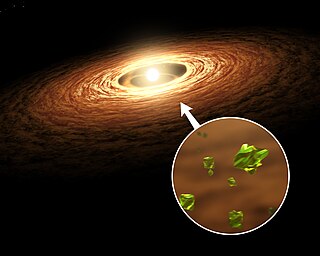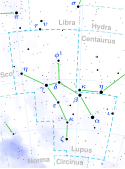EX Lupi
| Stern EX Lupi | |||||||
|---|---|---|---|---|---|---|---|
 | |||||||
| Künstlerische Darstellung | |||||||
| AladinLite | |||||||
| Beobachtungsdaten Äquinoktium: J2000.0, Epoche: J2000.0 | |||||||
| Sternbild | Wolf | ||||||
| Rektaszension | 16h 03m 5,49s [1] | ||||||
| Deklination | −40° 18′ 25,4″ [1] | ||||||
| Helligkeiten | |||||||
| Scheinbare Helligkeit | 8,5 (8,5 bis 14,3) mag [1][2] | ||||||
| Spektrum und Indices | |||||||
| Veränderlicher Sterntyp | EXOR[2] | ||||||
| B−V-Farbindex | (2.9) [1] | ||||||
| Spektralklasse | M0 [1] | ||||||
| Astrometrie | |||||||
| Parallaxe | (6,34 ± 0,04) mas [1] | ||||||
| Entfernung | (514 ± 3) Lj (158) pc | ||||||
| Eigenbewegung [1] | |||||||
| Rek.-Anteil: | (−10,10 ± 0,08) mas/a | ||||||
| Dekl.-Anteil: | (−22,54 ± 0,05) mas/a | ||||||
| Physikalische Eigenschaften | |||||||
| Masse | 0,6 M☉ [3] | ||||||
| Radius | 1,6 R☉ [3] | ||||||
| Leuchtkraft | |||||||
| Effektive Temperatur | 3800 K [3] | ||||||
| Andere Bezeichnungen und Katalogeinträge | |||||||
| |||||||
EX Lupi ist ein veränderlicher Stern im Sternbild Wolf. Er ist der Prototyp einer Unterklasse der T-Tauri-Sterne, die als EXors oder EX-Lupi-Sterne bezeichnet werden und durch optische Ausbrüche von 1 bis 4 mag gekennzeichnet sind, die jeweils etwa zehn bis einhundert Tage dauern und im Abstand von mehreren Monaten bis Jahren erfolgen. Sie sind meist Zwerge der Spektralklassen K oder M. Wie alle T-Tauri-Sterne ist EX Lupi selbst auch jung, nur einige Millionen Jahre alt.
Eine Besonderheit dieses jungen Sterns ist, dass Péter Ábrahám vom Konkoly-Observatorium in Budapest und seine Kollegen bei ihm beobachten konnten, wie Silikatkristalle entstehen. Dies schlossen sie daraus, dass während eines Strahlungsausbruchs die typischen Linien von Silikatkristallen im Spektrum des Sterns auftauchten. Dies wird als Hinweis auf die Herkunft von Silikatkristallen in Kometen gewertet.[4]
Weblinks
- Max-Planck-Institut: Wo wurden die Kometenkristalle gebacken?
- G. H. Herbig: EX Lupi: History and Spectroscopy. In: The Astronomical Journal. Band 133, Nr. 6, 2002, S. 2679–2683, doi:10.1086/517494.
Einzelnachweise
- ↑ a b c d e f HD 325367. In: SIMBAD. Centre de Données astronomiques de Strasbourg, abgerufen am 31. Oktober 2018.
- ↑ a b EX Lup. In: VSX. AAVSO, abgerufen am 31. Oktober 2018.
- ↑ a b c d N. Sipos et al.: EX Lupi in quiescence. In: Astronomy & Astrophysics. Band 507, Nr. 2, 2009, S. 881–889, doi:10.1051/0004-6361/200911641, arxiv:0906.3168v1.
- ↑ Junger Stern: Strahlungsausbruch erzeugt Kristalle. Abgerufen am 4. September 2012.
Auf dieser Seite verwendete Medien
This artist's concept illustrates how silicate crystals like those found in comets can be created by an outburst from a growing star. The image shows a young sun-like star encircled by its planet-forming disk of gas and dust. The silicate that makes up most of the dust would have begun as non-crystallized, amorphous particles.
Streams of material are seen spiraling from the disk onto the star increasing its mass and causing the star to brighten and heat up dramatically. The outburst causes temperatures to rise in the star's surrounding disk.
When the disk warms from the star's outburst, the amorphous particles of silicate melt. As they cool off, they transform into forsterite (see inset), a type of silicate crystal often found in comets in our solar system.
In April 2008, NASA's Spitzer Space Telescope detected evidence of this process taking place on the disk of a young sun-like star called EX Lupi.Autor/Urheber:
- Lupus_constellation_map.png: Torsten Bronger
- derivative work: Kxx (talk)
Lupus constellation map



